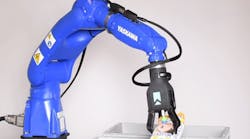With almost all technology, time is your friend, and time has a habit of improving the state of technology through any number of advances and improvements. These advances affect all aspects of any given device, including the size, price, usability, and flexibility for the application of that technology. Innovative improvements in vision are no exception, and vision technology as it relates to robots is even more prominent, renewing interest in the use of Vision Guided Robotics (VGR) in the manufacturing of parts and packaging of goods.
Robots, especially for welding and assembly, have consistently excelled at repeating predefined tasks against rigid, well-defined objects that are always in the same location. However, once those objects vary in shape, or are not always in the exact same location, robots fail. For this reason, another tool is required to mitigate the problem—vision. If the robot does not “know” where the object is, it needs to be able to “see” it to find it. Without some type of assistance, the robot is “blind”.
The Beginning of Vision Guided Robotics
Original cameras and sensors were slow to perform, sensitive to extraneous light, and costly to implement. The tools to work with them were also virtually nonexistent. Likewise, many early vision systems were purpose-built and offered little room for flexibility. This resulted in systems that were expensive and unreliable. 2D solutions tried to bridge the gap between a rigid part always located in the same position, and that same part that could possibly be varied in its actual location. Similar to a guide dog assisting a visually impaired person, 2D cameras helped to notify the robot of the proper part location.
Over time, advancements in camera resolution and software tools enabled these systems to be more useful and easily implemented. Moreover, improvements in speed for the acquisition of images and recognition of parts facilitated vision systems to process moving objects (i.e., parts on a conveyor). These concepts for improved resolution and processing also translated to part inspection, prompting companies to harness the same technology to help with part quality identification. While innovations in vision technology greatly expanded the usability of vision systems, their two-dimensional nature (where the camera detects objects in a single plane) was still very limiting for certain applications. After all, how can a part truly be detected, if the entire part cannot be “seen”?
The Introduction of Integrated Lighting
Advances in technology worked their way into improving three-dimensional (3D) vision, which some call the “holy grail” of VGR. This is especially true for random bin picking. When objects are presented randomly, particularly when they are stacked upon each other, an automation solution is now able to sense randomly placed parts and determine how to handle them through the use of structured, integrated lighting and 3D CAD matching. Continual improvements in camera technology and processing software have made this a reality, equipping a robotic system with the complete ability to find, recognize and pick an object – all without user programming.
Machine Vision Technology Helps Bridge the Gap
Technological trends continue to improve on all fronts. Vision systems have become proficient at merging 2D image features with data captured with 3D sensors, such that the part location and orientation can be calculated in just seconds.
As software progresses to match the speed and diversity of camera hardware, vision systems continue to be easier to install, use and maintain. Likewise, increased performance and greater flexibility enable robots to perform tasks with better precision and speed, while artificial intelligence allows vision systems to learn and adapt based upon previous “experiences”. Today, 2D and 3D vision-guided systems are effectively bridging the gap for many applications in diverse industries, and the chances are very high that if an application challenge is present some type of robotic vision capability is now available to help. And remember, if that solution is not available now, just wait, as technology continues to improve.










